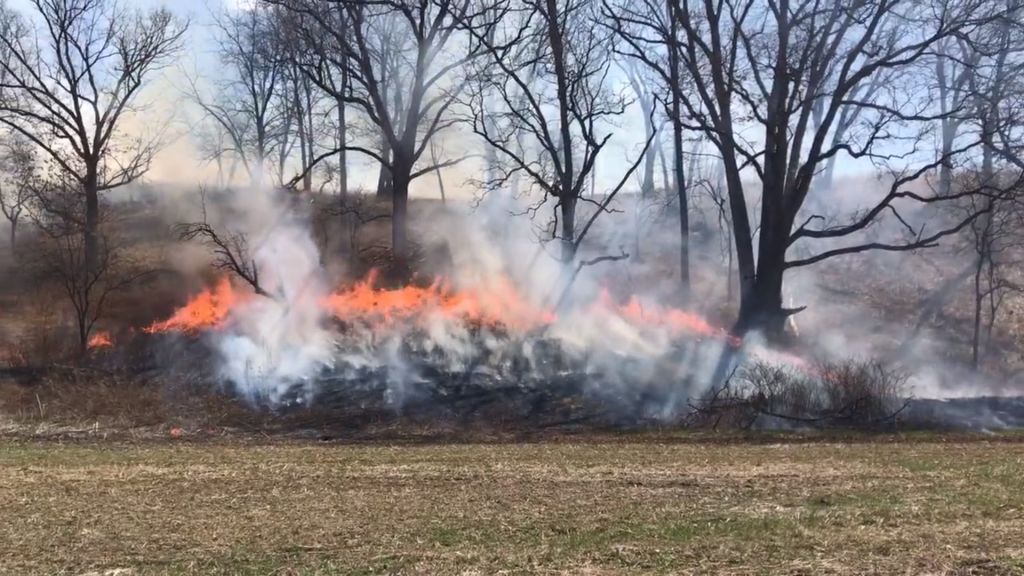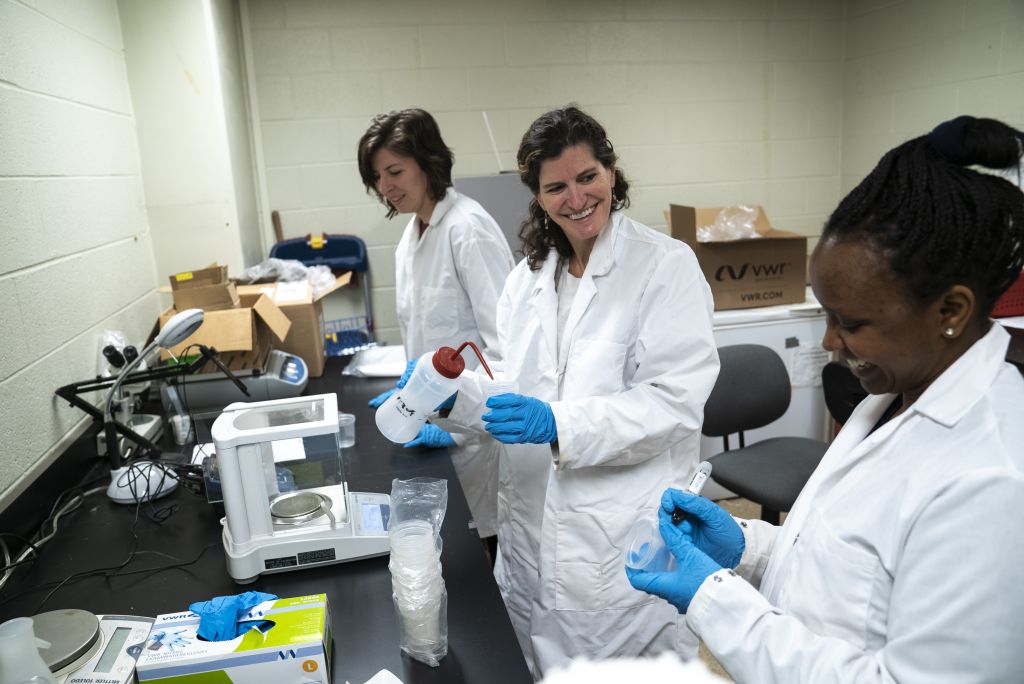Trailblazers: Erica Smithwick Rethinks Fire in the Forest

Erica Smithwick is a fire ecologist. As the director of Penn State’s Ecology Institute, she hopes to protect forests and stave off the effects of climate change and insect infestation through controlled forest fires. “A lot of my work has been out west working on wildfire recovery,” she said, “particularly in the Greater Yellowstone Ecosystem. I still have a graduate student, Jamie Peeler, who is continuing some of that work.”
Wildfires were used as a tool in the natural landscape until the U.S. Forest Service embraced a fire suppression policy in 1905, which resulted in a heavy fuel load on the forest floor and catastrophic fires. Since 1944, Smokey Bear has been sounding the alarm about human-caused forest fires, but that sentiment has evolved as the benefits of controlled strategic burns began to be studied.
In 2009, the Pennsylvania Prescribed Burning Practices Act empowered forest managers to use prescribed fire to promote the growth of young trees, restore native plants, control invasive species and reduce wildlife danger without liability.
“We have managers coming to us saying, hey, we're interested in putting fire back on this landscape safely and how do we do that, and what does the community think? We had engaged faculty and we said we can do this. It would be interesting to compare what was happening in Pennsylvania to a place like New Jersey, where they have been burning for 100 years.” Locally, prescribed burns in the Scotia Barrens outside of State College have been conducted to improve wildlife habitat and act as a firebreak for future burns by reducing the litter on the forest floor.
A big component of reintroducing prescribed burns was working with managers and community groups to find out how different user groups viewed controlled management of their forest, to identify areas of overlapping agreement and concerns.
“We did surveys of recreational users of forests in the local area. We're running a household survey right now, and we also conducted focus groups with managers. We revisited the places where they had put burns in the landscape to see if the trees were regenerating and did some modeling to forecast those ecological effects down the road.
“One of the surprises that came out of the surveys was that people hate ticks. If there's any potential role of returning forests to a healthier condition and getting rid of ticks, that would be a great benefit to communities. This research is ongoing, but there is encouraging news that there is some impact on ticks, but one of the reasons we burn here in Pennsylvania is to reintroduce game species like deer, turkey, and grouse. Sometimes those animals can also be carriers of ticks over the long term.”
Pennsylvania’s forests are quite young, having been extensively logged in the late 1800s and early 1900s. At 16.8 million acres, they cover 58% of the Commonwealth. “These are like baby forests,” Smithwick said. “They haven't developed the structural complexity that took thousands of years to create a primeval forest, if you will. We have a lot to lose here in Pennsylvania. We have beautiful forests; we're one of the most forested states in the country. But the management of that system, creating biodiversity, creating the successional stages properly on the landscape so that you can have continual growth, that's going to be our challenge,” she explained.
“One of the reasons we're reintroducing fire is because we want to have species adapted to young, open forests, as well as to ensure we have places for old growth. This will allow higher levels of biodiversity across our landscapes.”
If you look at a vegetation map of Pennsylvania, the line basically parallels I-80 in terms of a boundary between a northern temperate forest, cooler forest types, and more southerly forest types. Science tells us that the boundary is likely to shift northward, as there are more warm adaptive species that can push into the cold adaptive zones. This may take many years to play out but some of the colder adaptive species will die out or become more vulnerable to pests, pathogens, and other stressors in the system.
“As those species slowly die out, the question is, how long will it be until other new species are able to come in?” Smithwick asks. “We have southern pine species, for example, that could move into this kind of system. As a fire ecologist, that makes me wonder, is it going to promote more fire hazard here and require more fire management? Also marching northward are pests and pathogens and invasive species. The southern pine beetle is now in New Jersey. We have the emerald ash borer, all these other kinds of pests and pathogens that are threatening our forest. That's a real concern.”

In addition to her work with prescribed burns, Smithwick runs other research projects that explore the intersection of climate, ecology, and society. She’s reached the halfway point of a natural human systems project called Visualizing Forest Futures (VIFF) which seeks to address how indigenous and western knowledge systems can be best used to address forest sustainability under climate variability, a five-year project with the Menominee Indian Tribe of Wisconsin.
“We’re working with the tribe to help them prepare and plan for the potential impact of climate change on their forests. The forest is the basis of their economy, but it's also part of their cultural heritage as well. We're not making decisions for them, but we're aiding in that decision-making process. We use the traditional approach of modeling, then link that to virtual reality experiences.
“Once this is fully developed as a tool, we can use it to elicit values about forests of the future that you can't experience today. How do you know what you're going to miss if you don't miss it yet? That's one motivating factor,” she said. “We then use those values that we learn about from the communities to think about whether there's trade-offs or synergies about management trajectories because we can do scenarios. We expect that different stakeholders will see different things in that forest, and how do you weigh those different values?
Smithwick also recently embarked on a research project in coastal Alaska, where the indigenous communities of Dillingham, Wainwright, and Scammon Bay are facing rapid environmental and social changes. The project, “Pursuing Opportunities for Long-term Arctic Resilience for Infrastructure and Society,” (POLARIS) led by Guangqing Chi is working to identify environmental challenges and building more resilient communities.
She will be the lone ecologist among a dozen or so collaborators, mostly social scientists. The main pillars of this research are food security, infrastructural integrity and resilience, and out-migration, where people are leaving their communities and relocating to cities and impacting the environment they leave behind.
Another of Smithwick’s transdisciplinary collaborations is a new graduate training program called LandscapeU, a National Science Foundation National Research Traineeship (NRT) program that brings together graduate researchers from across the University to study the food-energy-water system in the Chesapeake Bay watershed.
“What we're trying to do is reinvent transdisciplinary training approaches for our graduate students. LandscapeU and the VIFF projects are examples of how you co-design projects in collaboration with decision-makers and communities. It takes the land grant model and brings it across all of our fields of inquiry so that we can be engaged partners from the very beginning in helping to design the kind of science we're doing,” she said.

Smithwick received her Ph.D. in Forest Science/Ecology from Oregon State University after earning her Masters in Forestry/Resource Conservation from the University of Montana. She is also an E. Willard and Ruby S. Miller Professor of Geography and serves as the associate director of the Institutes of Energy and Environment (IEE). She’s been director of the Huck- and IEE-sponsored Ecology Institute since 2017.
The Institute is comprised of 65 faculty members from an array of colleges including Earth and Mineral Sciences, Science, Agricultural Sciences, Arts and Architecture, and Liberal Arts. It is an “Inter-Institute” Institute, a 50/50 split position between Institutes of Energy and the Environment (IEE) and Huck. The unit grapples with the big ecological issues of the day, including climate change impacts and potential solutions, responsible land stewardship, fire and flood impacts, and ecosystem resilience in the face of biodiversity collapse, invasive species, and exurban development.
“Penn State's unique strength lies in its interdisciplinarity and tops NSF rankings for breadth of research expertise,” Smithwick said. “The fact is a lot of us are collaborating. And there's an intentionality and positivity to those interactions that's very exciting. We have the depth and breadth in all the relevant disciplines that are needed to tackle these tough societal and ecological problems.”
“How can we bring the strengths of all of the units of Penn State to bear on those problems? With an ecological lens, of course.”